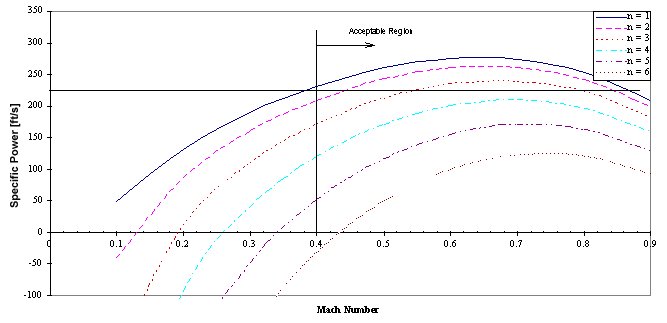|
||||||||||
|
|
||||||||||
|
||||||||||
|
|
||||||||||
|
|
|
||||||||||||||||||||||||||||||||||||||||||||||||||||||||||||||||||||||||||||||||||||||||||||||||||||||||||||||||||||||||||||||||||||||||||||||||||||||||||||||||||||||||||||||||||||||||||
|
Compliance Summary:The AIAA RFP and military specifications (MILspecs) call for the Storm Shadow to meet certain requirements. The Storm Shadow meets or exceeds all these requirements, as indicated in the table below.
Design Requirements Compliance Summary
Rates of Climb:The rates of climb (R/C) for the Storm Shadow were calculated at velocities corresponding to Mach 0.1 through 0.9 and at various altitudes. The resultant graph shows that the aircraft maintains positive rates of climb at all required altitudes.

Rates of climb vs. velocity
Range Determination:Using the altitudes and velocities specified by the RFP and fuel consumption data provided by propulsion calculations, the ranges for the three missions specified in the RFP were determined. Mission 1 calls for a total range of 1,600 NM cruising at 40,000 ft at Mach 0.7. The Storm Shadow is designed to carry 850 lb of fuel giving it a total range of 1,667 NM. Mission 2 calls for 200 NM ingress and egress segments flown at 250 ft at Mach 0.9. The mission also calls for cruise segments before and after the bomb run. For consistency and to optimize the range, these segments were analyzed at 40,000 ft and Mach 0.7. The range was computed both with the bomb released halfway (mission completed) and with the bomb remaining aboard during the entire flight (mission aborted). In the first case, the total range is 770 NM but drops to 746 if the mission is aborted. Mission 3 calls for a 3,000 NM ferry range (e.g. ferrying the aircraft to a forward base). To accomplish this, a fuel tank can be carried in place of the bomb. Flying at 40,000 ft at Mach 0.7, the aircraft can travel 3,011 NM if this drop tank holds 430 lb of fuel. If the aircraft were to carry its maximum fuel capacity (assuming a fuel tank occupying the entire bomb bay) and cruise at its optimum (i.e. most fuel efficient) point, the range jumps to almost 4,000 NM. These range estimates are summarized in the figure below.

Storm Shadow range for each mission
Specific Excess Power:Specific power is the rate at which an aircraft gains altitude or velocity. The specific excess power is specific power divided by weight. Since drag is a function of the aircraft load factor (i.e. the number of g's experienced in a maneuver), the specific excess power was calculated as a function of load factor. The RFP requires a specific excess power of at least 225 ft/s at 5,000 ft at Mach 0.4 or more. As shown below, the Storm Shadow exceeds this requirement for a load factor of 1.

Specific excess power at 5,000 ft
Flight Envelope:The flight envelope consists of four curves corresponding to the clean stall speed, the thrust limit, zero rate of climb, and maximum engine operation speed. The resulting operational limits on the aircraft are shown below.

Flight envelope |


|
Aircraft | Design | Ask Us | Shop | Search |

|
|
| About Us | Contact Us | Copyright © 1997- | |||
|
|
|||